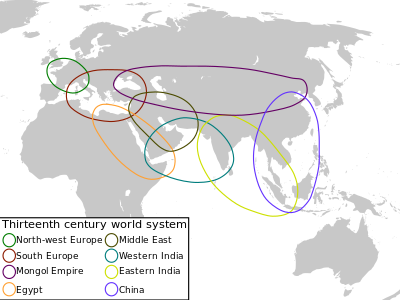
Back العولمة القديمة Arabic প্রাচীন বিশ্বায়ন Bengali/Bangla Globalisasi kuno ID 고대의 세계화 Korean لرغونی نړیوالتوب Pashto/Pushto Globalização arcaica Portuguese 古代全球化 Chinese

Archaic globalization is a phase in the history of globalization, and conventionally refers to globalizing events and developments from the time of the earliest civilizations until roughly 1600 (the following period is known as early modern globalization). Archaic globalization describes the relationships between communities and states and how they were created by the geographical spread of ideas and social norms at both local and regional levels.[1]
States began to interact and trade with others within close proximity as a way to acquire coveted goods that were considered a luxury. This trade led to the spread of ideas such as religion, economic structures and political ideals. Merchants became connected and aware of others in ways that had not been apparent. Archaic globalization is comparable to present day globalization on a much smaller scale. It not only allowed the spread of goods and commodities to other regions, but it also allowed people to experience other cultures. Cities that partook in trading were bound together by sea lanes, rivers, and great overland trade routes, some of which had been in use since antiquity.[2] Trading was broken up according to geographic location, with centers between flanking places serving as "break-in-bulk" and exchange points for goods destined for more distant markets.[2] During this time period the subsystems were more self-sufficient than they are today and therefore less vitally dependent upon one another for everyday survival.[2] While long-distance trading came with many trials and tribulations, still so much of it went on during this early time period. Linking the trade together involved eight interlinked subsystems that were grouped into three large circuits, which encompassed the western European, the Middle Eastern, and the Far Eastern circuits. This interaction during trading was early civilization's way to communicate and spread many ideas that caused modern globalization to emerge and allowed a new aspect to present-day society.[citation needed]